Oscars are an aggressive and highly intelligent freshwater fish hailing from South America, specifically the tropical Amazon River Basin and its tributaries. They go by many names, including velvet cichlids, tiger Oscar, and marbled cichlids. Oscars are popular in aquariums and require very large tank setups with similar water conditions to their natural habitat.
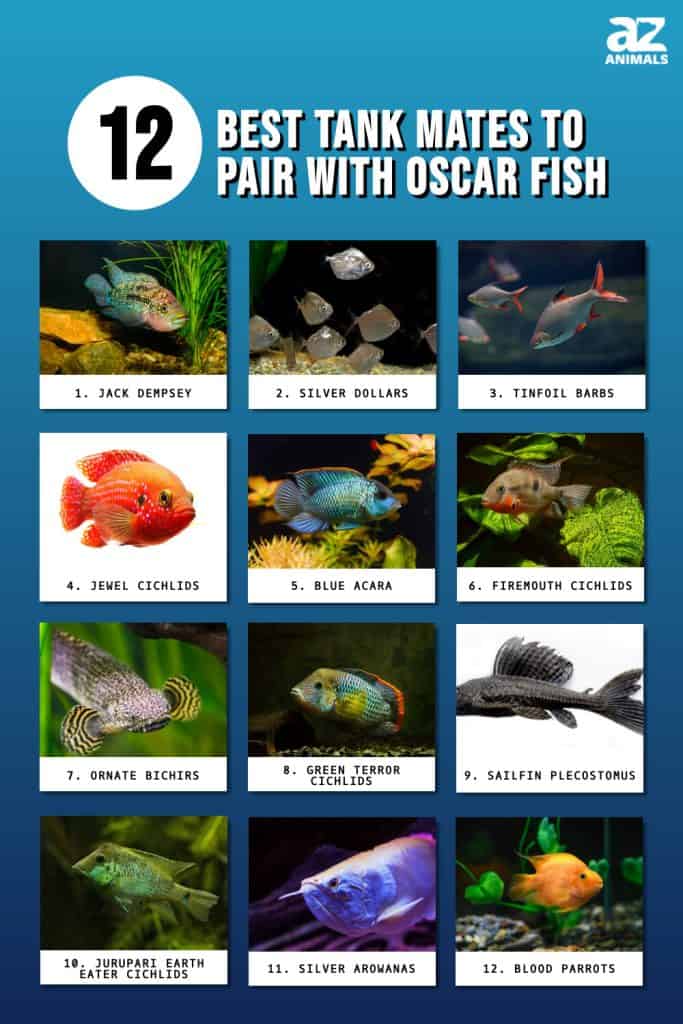
Although Oscars are usually housed alone, it is possible for them to coexist in the same tank as other fish. However, there are only a few compatible tank mates for Oscars and there is no guarantee that they will always get along.
Choosing a suitable tank mate for Oscars can be challenging, but this article will help narrow down your options.
Oscar Fish Overview
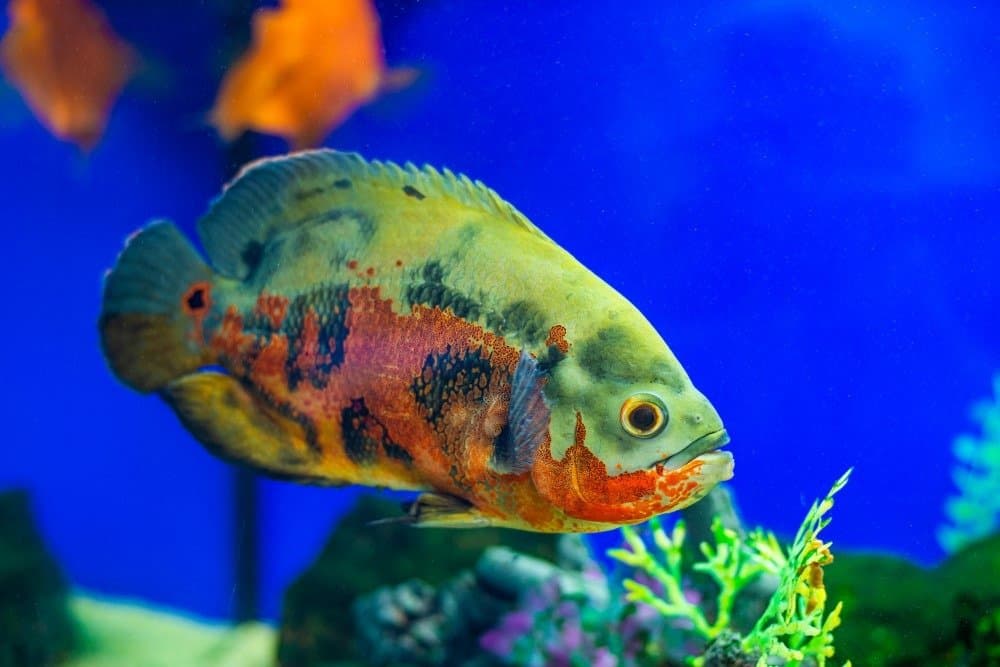
Oscars are well known for being aggressive aquarium fish.
©elpashtetto/Shutterstock.com
| Scientific name: | Astronotus ocellatus |
| Origins: | South America |
| Minimum tank size: | 55 gallons |
| Lifespan: | 10 to 15 years |
| Diet: | Carnivores |
| Water temperature: | 75° to 80° Fahrenheit (23° to 27° Celsius) |
| Adult size: | 10 to 15 inches long |
| Varieties: | Tiger, lemon, red, veil tail, copper, and black Oscar |
Finding a Suitable Tank Mate for Oscars
Oscars can be very aggressive and fussy fish that do not always tolerate having tank mates. They seem to get along best with any fish that they have been raised with from a small size or cannot fit into their mouths. Their tank mates should be other large and tropical fish that thrive in the same water conditions as Oscars.
Most Oscars won’t bother with tank mates that are too large for them to eat. However, they will kill and eat any fish or invertebrates that can fit in their mouth. Any fish with long and flowy fins should be avoided as tank mates as Oscars can badly damage their fins.
Keep in mind that you will need to upgrade the size of your Oscars tank if you house them with other fish. An agreeable minimum tank size for most Oscars is between 55 to 75 gallons. With tank mates included, most Oscars need a minimum of 75 gallons or larger.
Oscars do not make good community fish, and they have a very low compatibility rate in comparison to many other species of fish.
The Best Tank Mates for Oscar Fish
Let’s discuss the 12 best tank mates for Oscar fish and how well they pair in aquariums.
1. Jack Dempsey (Rocio octofasciata)
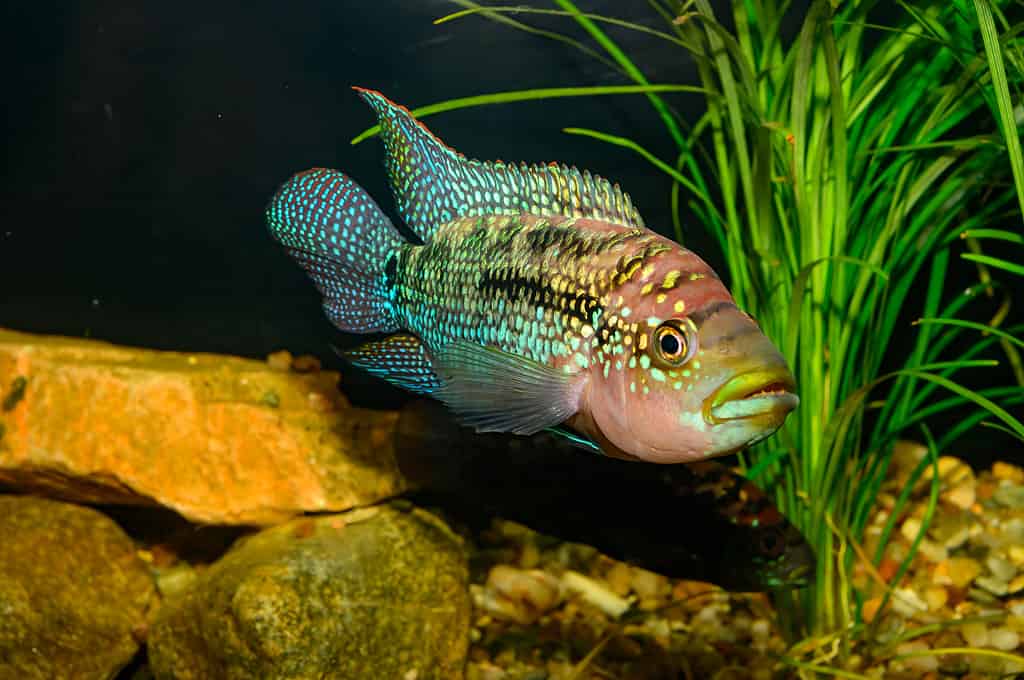
The Jack Dempsey is a semi-aggressive cichlid that can change colors depending on their mood.
©Karel Zahradka/Shutterstock.com
The first tank mate on our list is the Jack Dempsey cichlid which has a similar temperament to Oscars. Jack Dempsey has a striking appearance, consisting of vibrant green, blue, pink, purple, and black hues. They are known for their ability to change colors depending on their mood and environment. When Jack Dempsey is stressed, they can darken their coloration to make it appear faded. They reach a similar adult size to Oscars at 10 to 15 inches long.
You should only keep Jack Dempsey with Oscars if specific conditions have been met. They both require a spacious tank with a powerful filtration system. Water quality is essential for their health and longevity, so be sure to cycle their aquarium before adding them in. Jack Dempsey and Oscars are both aggressive and territorial, so it is important to keep them together if they are the same size.
For example, a 4-inch Jack Dempsey should only be housed with Oscars around 3 to 6 inches long. They may eat each other if they can fit one another in their mouths.
2. Silver Dollars (Metynnis argenteus)
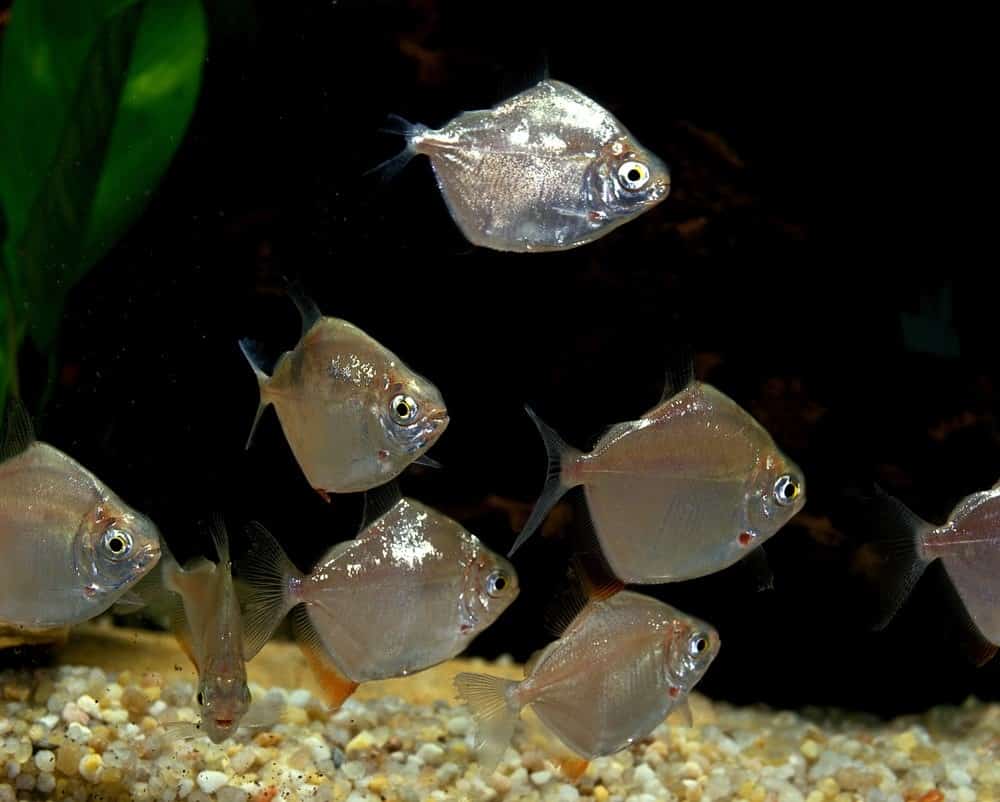
It is important to keep silver dollars together in groups of six or more as they are schooling fish.
©slowmotiongli/Shutterstock.com
Silver dollars are a fascinating tropical fish with a distinctive pancake-shaped body. They are native to South America and inhabit a similar natural habitat to Oscars. Silver dollars are naturally peaceful and social fish that should be kept in groups of six or more to form a school. You should never house silver dollar fish alone or in pairs, even if they are kept in the same tank as Oscars.
Oscars and silver dollars can get along well in a spacious aquarium, provided that the silver dollars are too large to fit in their mouths.
Most silver dollars grow to around 6 to 8 inches long, which is usually too large for adult Oscars to fit into their mouths. They have a shiny silver appearance but can be found in spotted varieties. Male silver dollars have a red-tinged anal fin and a bluish hue along their underside. Silver dollars are omnivores and have very small mouths that they use to consume a vegetarian-based diet. However, silver dollars will occasionally feed on meat or small prey animals like bloodworms and brine shrimp.
3. Tinfoil Barbs (Barbonymus schwanenfeldii)
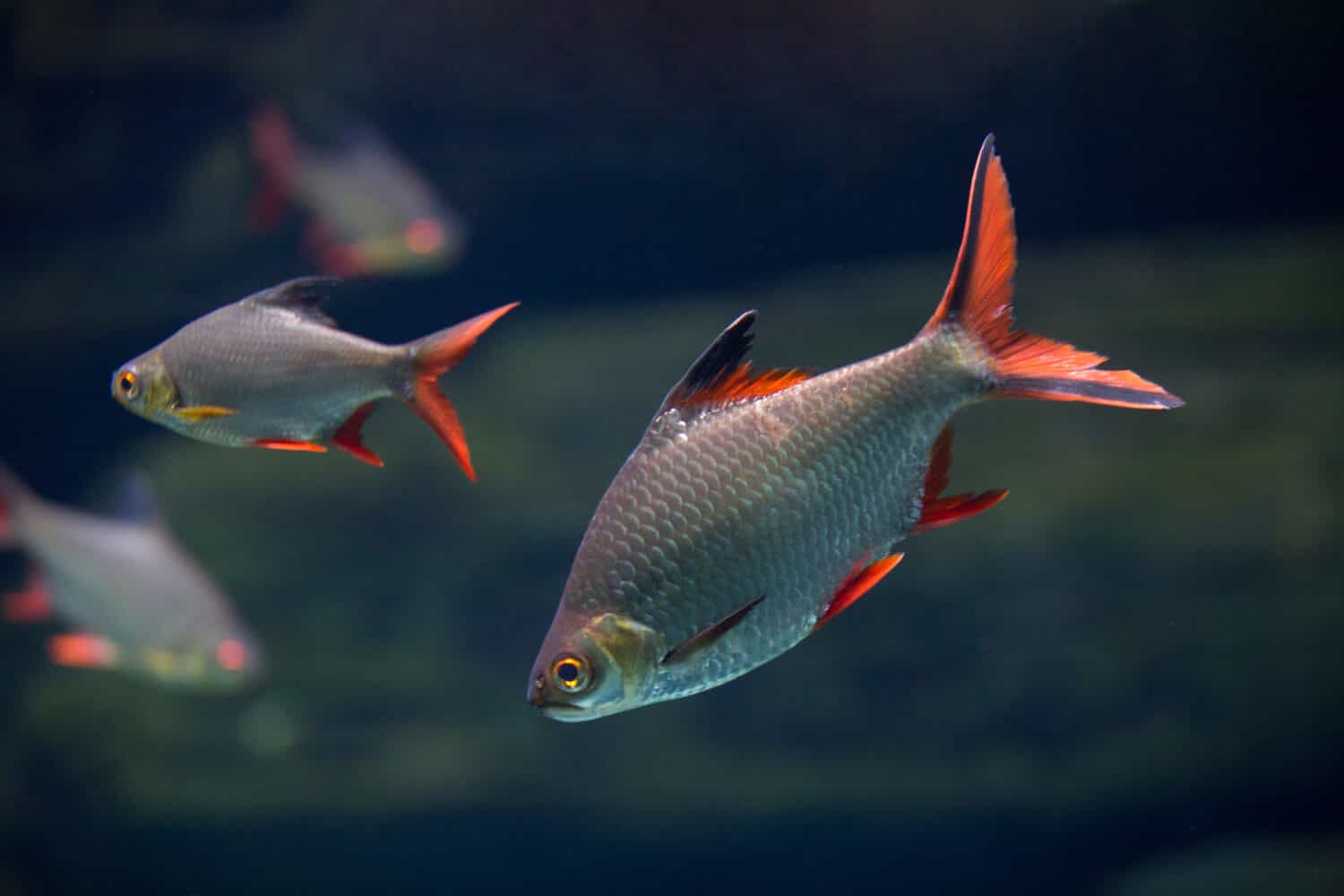
The tinfoil barb is a schooling fish that should be kept in groups of at least five or six.
©ivSky/Shutterstock.com
Silver dollars and tinfoil barbs are sometimes mistaken for the same species, but they are different. Tin foil barbs have a slightly wide-body structure and grow much larger at 10 to 14 inches long. Their body is a silver color paired with either red, orange, or yellow fins.
They are very large fish that need a spacious and heated tank over 75 gallons in size. When keeping tinfoil barbs with Oscars, the tank will need to be well over 120 gallons long. Much like the silver dollar, tinfoil barbs are social fish that need to be kept in groups of five or more.
Tinfoil barbs are omnivores and often the first to the food. They enjoy scavenging and eating foods around the aquarium and might try to eat an Oscars food. To discourage Oscars and tinfoil barbs from competing for food, try feeding them on different sides of the tank at the same time.
4. Jewel Cichlids (Hemichromis bimaculatus)
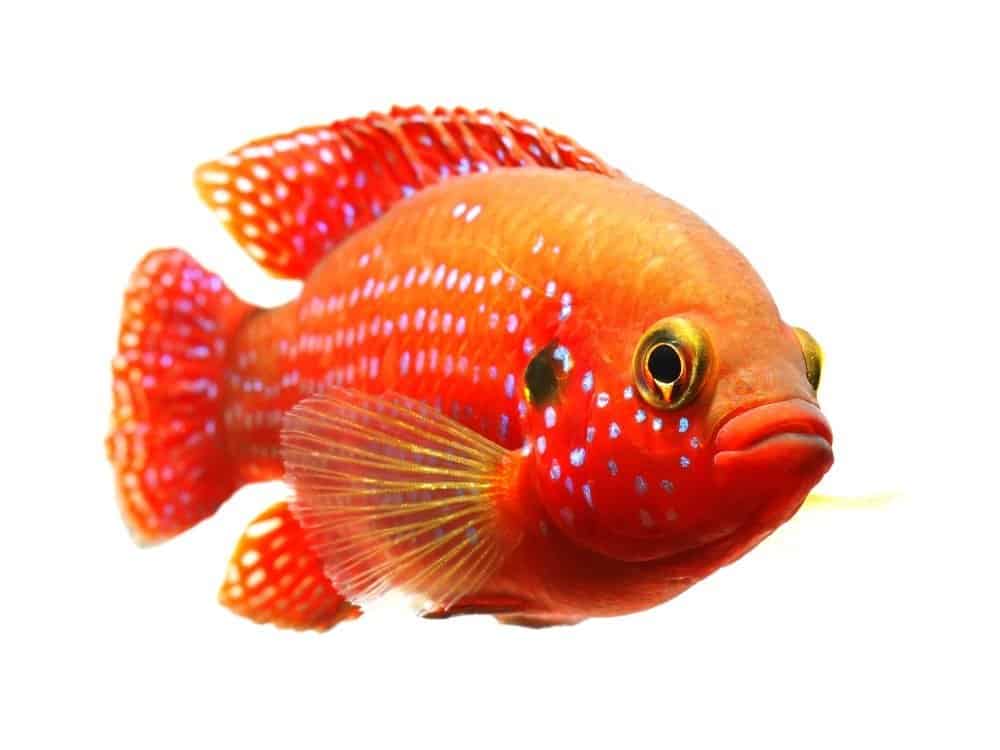
The African jewelfish has a striking reddish-orange coloration that makes them striking.
©Grigorev Mikhail/Shutterstock.com
Jewel cichlids, also referred to as red cichlid or African jewelfish, are freshwater fish native to Africa and Central South America. They can be distinguished by their vivid reddish-orange coloration and sparkling white or blue markings. Jewel cichlids grow to around 6 inches in length, so they are compatible with juvenile Oscars under 10 inches in size.
Oscars and jewel cichlids should only be kept together if the tank is larger than 75 gallons. They need plenty of swimming space and jewel cichlids can benefit from various hiding spots in the tank. You can either use live plants, caves, or rock formations to make the jewel cichlids feel more secure in an Oscars aquarium. Jewel cichlids are equally as aggressive and territorial as Oscars, and they prefer to prey on smaller fish that they can fit into their mouths.
5. Blue Acara (Aequidens pulcher)
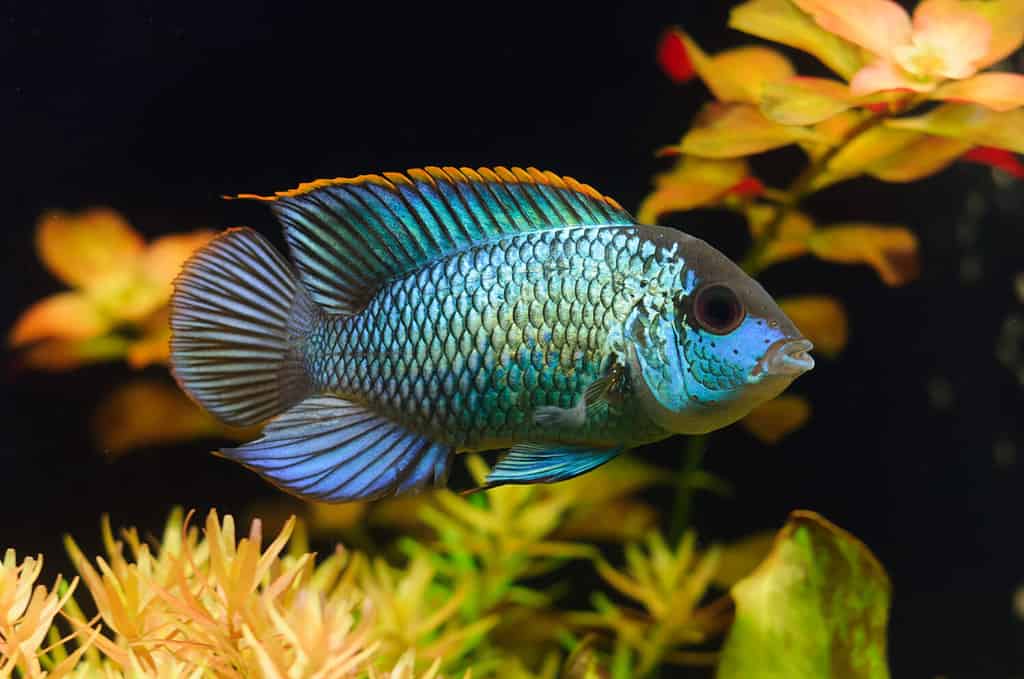
Blue acaras are hardy and adaptable fish that inhabit various wild habitats.
©tetiana_u/Shutterstock.com
The blue acara is a type of freshwater cichlid with a striking iridescent bluish-green body. They naturally inhabit slow-moving streams and rivers in South America with similar water conditions as Oscars. Blue acara can reach 6 inches in length as an adult, which makes them large enough to be housed with juvenile Oscars.
The blue acara has a mild temperament in comparison to Oscars as they are slightly more peaceful and docile. However, they can become territorial during the breeding season. If the tank is large enough, Oscars won’t have much problem sharing a tank with blue Acara. Both fish can be territorial and show signs of aggressive behavior like fin nipping and chasing.
Caring for blue acara is relatively simple and can thrive in most aquarium setups if their ideal water conditions are being met. Like Oscars, blue acara are tropical fish and require a large tank with ample swimming space and well-maintained water.
6. Firemouth Cichlids (Thorichthys meeki)
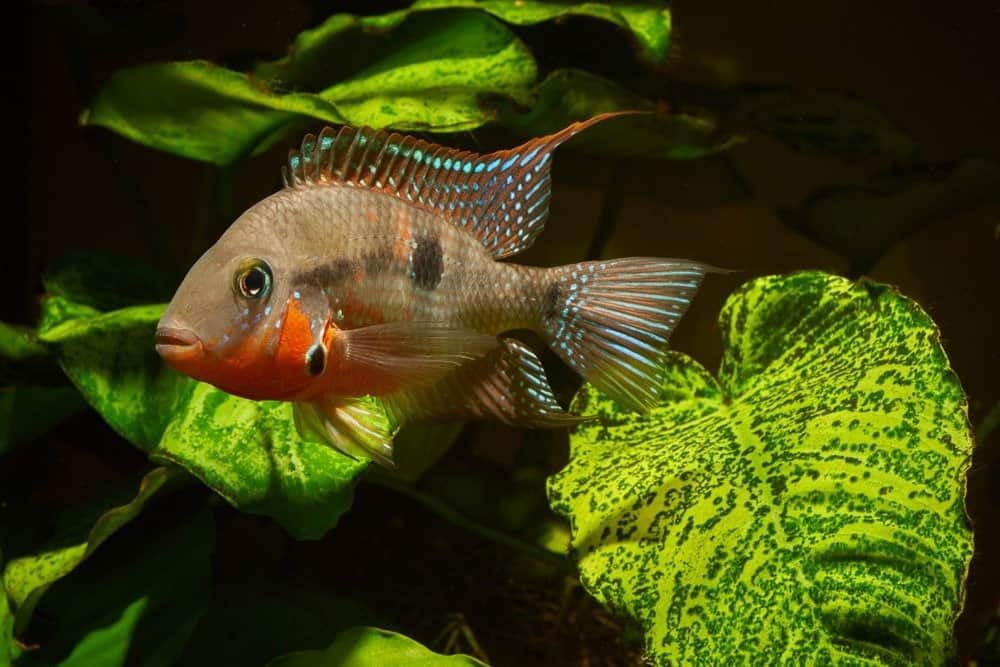
The firemouth cichlid is true to their name with their fiery red undersides.
©Johannes Menge/Shutterstock.com
Firemouth cichlids look exactly as their name suggests. These semi-aggressive cichlids have a primarily silverish body with neon red or orange coloration below their mouth and underside.
Firemouth cichlids originate from Central America in shallow and murky freshwater rivers. They thrive in similar water conditions as Oscars, and at a minimum tank size of 55 gallons. Firemouth cichlids tend to grow smaller in captivity than in the wild at around 5 to 6 inches long. They are compatible with juvenile Oscars but might be too small for fully grown adults.
Firemouth cichlids are omnivores but lean towards being carnivores. You can offer firemouth cichlids the same foods as Oscars, and they aren’t too picky about the foods they eat.
7. Ornate Bichirs (Polypterus ornatipinnis)
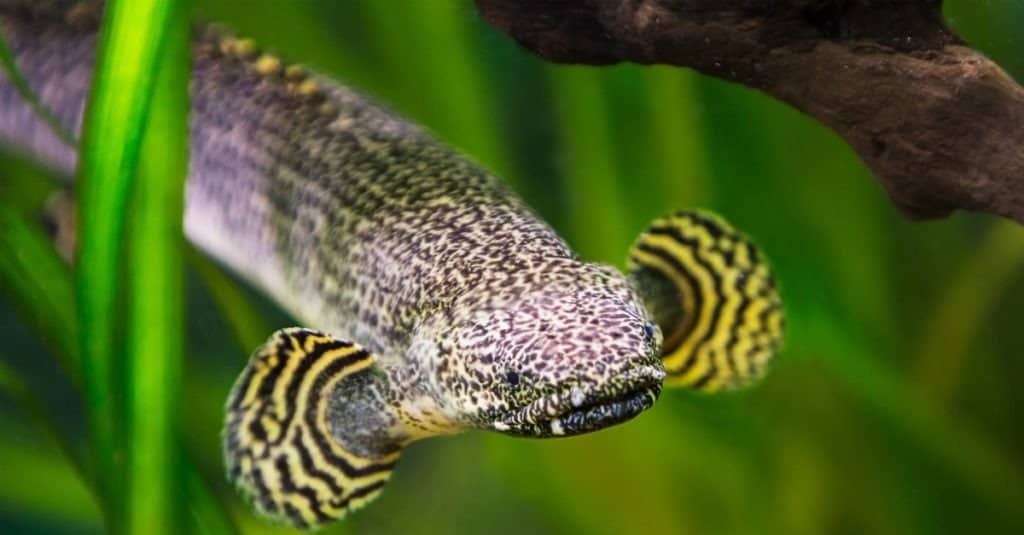
The ornate bichir is one of the most striking species in their genus.
©Galina Savina/Shutterstock.com
Bichirs are types of freshwater African fish that have elongated bodies and prefer to stay at the bottom of an aquarium. There are 12 species of bichirs belonging to the Polypterus genus, but the ornate bichir is usually recommended as a tank mate for Oscars.
The ornate bichir is native to Central and Eastern Africa and inhabits sluggish freshwaters with dense vegetation. They have thick, eel-like bodies that can reach 20 inches in length. Ornate bichirs have a striking yellow and black pattern that makes them stand out in aquariums.
While it is possible to keep ornate bichirs and Oscars together, you need to follow a few important considerations. Ornate bichirs can be semi-aggressive but rarely interact with Oscars in proper tank setups. They are primarily carnivores and feed on small prey animals like fish, crustaceans, and many invertebrates. You can offer ornate bichirs the same live foods as Oscars but avoid feeding them in the same spot to prevent fighting.
Ornate bichirs need really large tanks with at least 180 gallons of horizontal swim room. They are bottom-dwelling fish and need a sandy substrate they can easily glide across by scraping themselves. You should only keep Oscars with ornate bichirs if they are similarly sized. If one fish is larger than the other, they might begin fighting.
8. Green Terror Cichlids (Aequidens rivulatus)

Green terror cichlids typically grow between 10 to 12 inches long as an adult.
©Aleron Val/Shutterstock.com
The green terror is a large species of cichlid that grows up to 12 inches long. They originate from the South American river basins and thrive in freshwater and tropical aquariums above 75 gallons in size. Green terror cichlids are aggressive and territorial fish that have a fascinating appearance.
Their bodies are striking blue, green, orange, and brownish coloration with neon reddish-orange at the ends of their caudal (tail fins). You can keep green terrors and Oscars in the same tank, but you will need to ensure that they are the same size. Juvenile green terrors can easily get stressed out by Oscars who start to bully them, and this behavior can be prevented.
Avoid keeping small green terrors (under 4″) with Oscars, since Oscars can grow relatively quickly and prey on them. You will need to raise both fish together from a young age with no more than a 1-inch size difference.
9. Sailfin Plecostomus (Pterygoplichthys gibbiceps)
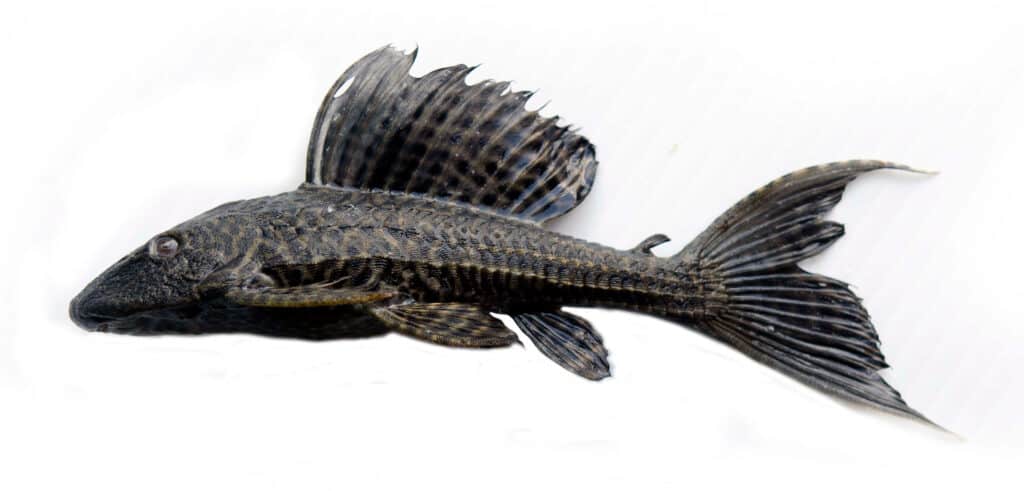
Sailfin plecos have very large dorsal fins that resemble the sails of a ship.
©KOCHAKORN MOONSATAN/Shutterstock.com
The sailfin pleco is a very large bottom-dwelling suckerfish from South America. They can grow up to 19 inches long in captivity which makes them compatible with adult Oscars. Sailfin plecos are named after their large and prominent dorsal fins. They have yellow to dark brown bodies with spots or squiggly markings. Unlike Oscars, the sailfin pleco is a peaceful fish that prefers to keep to themselves in an aquarium. They will hardly interact with Oscars when kept in a spacious aquarium over 125 gallons in size.
Furthermore, sailfin plecos are herbivores and feed off of algae. They usually don’t try to steal an Oscars food but don’t mind cleaning up any leftovers. If you choose to keep the highly compatible sailfin pleco and Oscar fish together, the sailfin pleco needs to be 3 to 6 inches larger than the Oscar because they grow relatively slowly.
10. Jurupari Earth Eater Cichlids (Satanoperca jurupari)
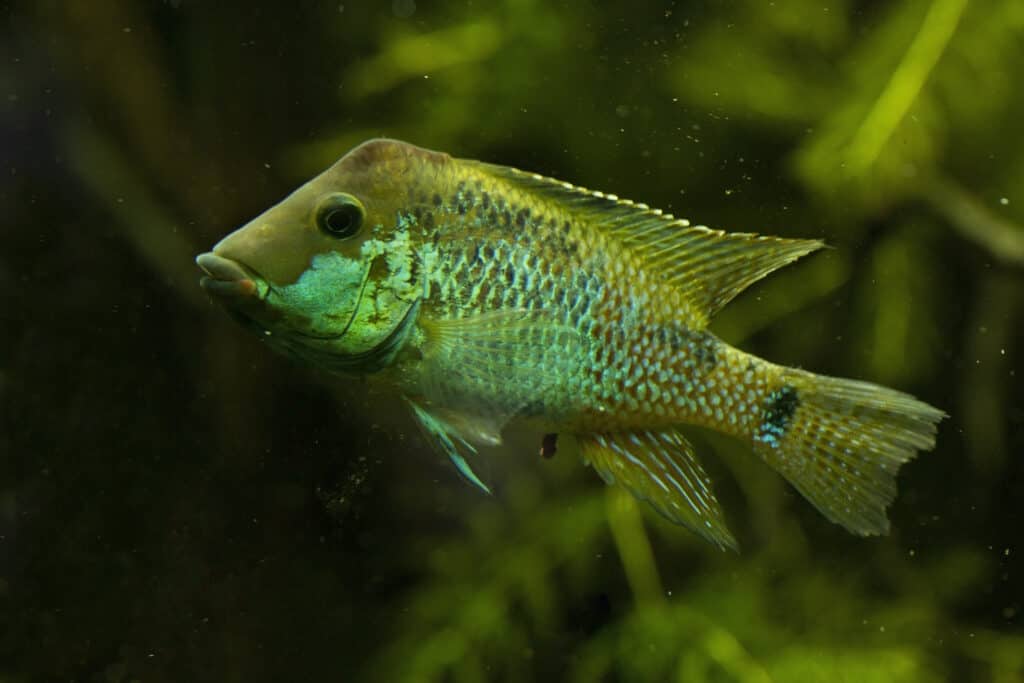
Earth eater cichlids are named after the way they sift through the substrate for food.
©Podolnaya Elena/Shutterstock.com
The Jurupari earth eater cichlid is named after their feeding habits since they sift through the substrate in search of food. They are semi-aggressive fish that reach around 8 inches in length. Most juvenile or adult Jurupari earth eater cichlids are compatible with Oscars when both fish are similarly sized.
They have a silver to pale brown coloration paired with yellow to greenish-blue markings. Their most distinctive feature is their large, protruding mouths that seem disproportionate to the rest of their body.
Jurupari earth eater cichlids require a minimum tank size of 75 gallons when kept with Oscars. A sandy substrate is recommended for these cichlids since they enjoy foraging in the substrate and eating an insect-based diet. However, most jurupari earth eater cichlids will eat any foods that are thrown into the tank.
11. Silver Arowanas (Osteoglossum bicirrhosum)
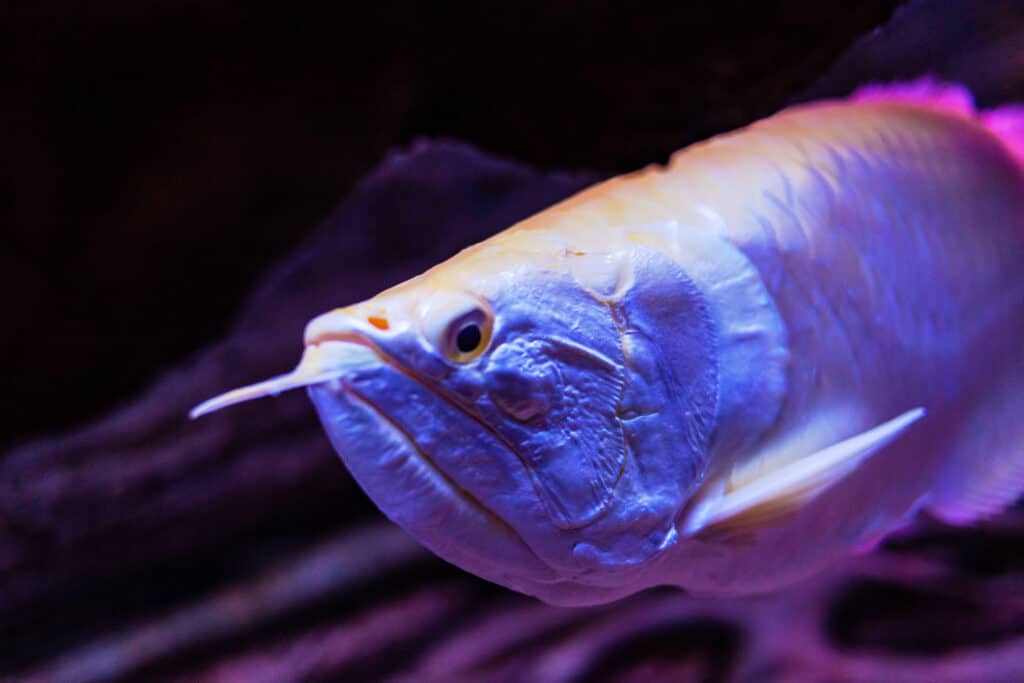
Silver arowanas are massive at around 4 feet long.
©iStock.com/KeongDaGreat
If you have the necessary tank space (over 200 gallons), then silver arowanas might be a good tank mate for your Oscar. Silver arowanas are very long eel-like fish that can grow up to 4 feet long, with 3 feet being more common. They are predatory freshwater fish that grow rapidly under the right conditions and with a proper diet. Silver arowanas have shiny silverish coloration with hints of brown and greenish-blue iridescent.
Although silver arowanas can be kept in the same tanks as Oscars, the Oscars need to be slightly larger. You ideally want to keep an adult Oscar with an 8-to-10-inch silver arowana and let the fish grow from there. In some cases, a fully grown silver arowana might no longer be compatible with Oscars and need to be separated. If you do keep them together, the tank needs to be over 250 gallons in size to support both species.
Silver arowanas are omnivores, so there is a concern that may eat Oscars.
12. Blood Parrots
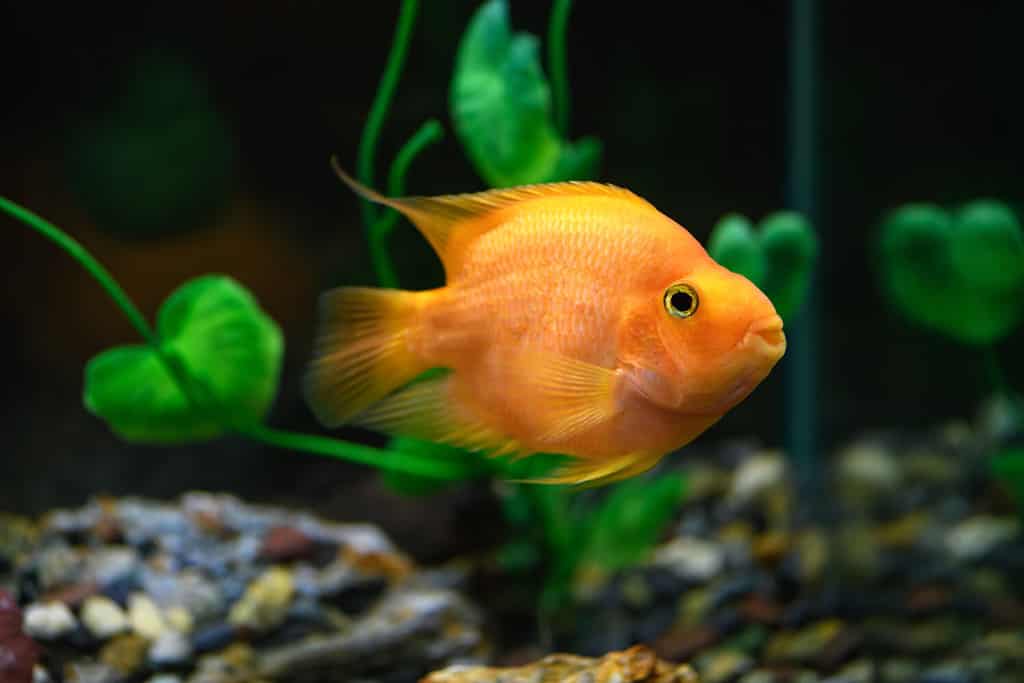
Blood parrots are man-made fish that cannot be found in the wild.
©Bk87/Shutterstock.com
The last best tank mate for Oscars on our list is the blood parrot which does not have a scientific name. Blood parrots are man-made species that are not naturally found in the wild. They are characterized by their vibrant red-to-orange coloration and have an average size of 8 to 10 inches. Blood parrots are very interesting and intelligent fish that are equally as rewarding to care for as Oscars.
Both fish can be kept in the same tank if it is well over 90 gallons in size and set up with hiding places from driftwood, plants, cave systems, or rock formations. However, the fish will need to be raised from the same size to prevent one from eating the other. Blood parrots can be kept in groups of their own kind, and this is encouraged to prevent them from being shy in aquariums.
As omnivores, blood parrots can eat the same food as Oscars and don’t mind eating more animal-based protein in their diet.
The Worst Tank Mates for Oscars
You want to avoid keeping Oscars with the following incompatible tank mates at all costs.
- Goldfish
- Koi
- Betta fish (Siamese fighters)
- Tetras
- Cory catfish
- Angelfish
- Livebearers (mollies, guppies, platies, swordtails)
- Gourami
- Rasboras
- Shrimp
- Snails
- Danios
- Kuhli loaches
- Discus
In Conclusion
Oscars can get along with certain fish species if they are kept in proper conditions and raised starting from a similar size. Some of the best tank mates for Oscars include other peaceful to semi-aggressive fish that reach over 6 inches in length. An Oscar’s tank mate should thrive at the same water parameters as them and share a similar diet.
Overall, the top three best tank mates for an Oscar fish are the sailfin pleco, Jack Dempsey, and the silver dollar.
Summary of The 12 Best Tank Mates for Oscar Fish
| Rank | Tank Mate |
|---|---|
| 1 | Jack Dempsey |
| 2 | Silver Dollars |
| 3 | Tinfoil barbs |
| 4 | Jewel cichlids |
| 5 | Blue acara |
| 6 | Firemouth cichlids |
| 7 | Ornate bichirs |
| 8 | Green terror cichlids |
| 9 | Sailfin Plecostomus |
| 10 | Jurupari earth eater cichlids |
| 11 | Silver arowanas |
| 12 | Blood parrots |
The photo featured at the top of this post is © iStock.com/Andrei310
Thank you for reading! Have some feedback for us? Contact the AZ Animals editorial team.






